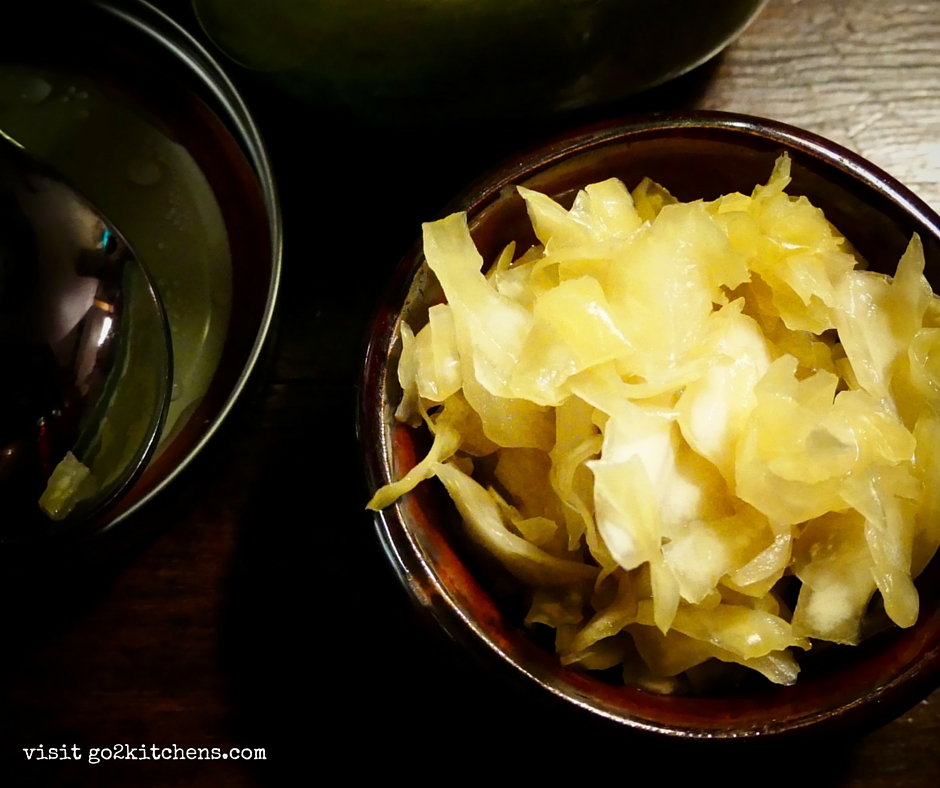Basic Sauerkraut Recipe
Every single time I have demo’ed how to make a basic sauerkraut recipe I get that deer in the headlight look from the audience. Not for the reason you are thinking! It is so easy that everyone is in shock! You will be too. There are just three ingredients and the worst part is waiting the 4-6 weeks for it to ferment! I have included some quick tips in this post for the best outcome and safety.
For the First Time Fermenter
This is a great place to start your fermenting journey. No doubt you have read all the amazing reasons you should be eating fermented foods here on my blog or somewhere else so I won’t bore you with repeat information! Let’s just get right down to my top tips for starting your fermenting journey. Fermenting can be intimidating. I mean let’s face it, you are growing bacteria that you are going to consume and assume that 1… you will not die and 2… that it can actually make you feel better. Never fear. here I am here to help!
My Top 10 Tips
- Make sure that your workspace, hands and tools are clean. Not antibacterial clean (we want to grow bacteria) but hot water and mild soap clean.
- Make sure your cabbage is not clean! Yep, your eyes are not deceiving you! Don’t wash your cabbage before you make this basic sauerkraut recipe. The dirt is actually what is going to help with the fermenting process.
- Use organic cabbage. The pesticides on conventional cabbage (non-organic) are actually easily absorbed in the body and you don’t want that!
- You can use purple or green cabbage. It is a personal preference.
- Cut cabbage in thin strips with a sharp knife. I don’t like to use a food processor because it makes the cabbage too thin and it can get mushy in the fermenting process.
- Use real sea salt. Add it in 1 teaspoon at a time. Too much salt will cause it to not ferment and too little will cause mold.
- Use Mason jars with wide mouths. This makes the pounding in the jar to remove air pockets so much easier. Makes filling the jars a snap too!
- Don’t skip the pounding because it will slow the ferment. If you don’t pound the cabbage it is not broken down and will not produce the liquids you need to make it ferment.
- Don’t believe that properly fermented sauerkraut can ferment in 2 weeks. The longer it ferments the more probiotics you get. The only way this rule could be broken is if you use a starter liquid from a previous ferment or a store bought brand.
- Make sure the liquids are always over the top of the mixture. Do not use chlorine tap water to top it off, it will kill your bacteria.
- BONUS TIP: When the 4-6 weeks is up and it is time to eat your fresh sauerkraut, GO SLOW! No more than a tablespoon a day for about 3-4 weeks if you never have eaten fermented foods. If you eat more you might have intestinal discomfort! Not fun!
Ok, get ready to ferment. Please post your questions below. We have an amazing community that is always around to help and I will see your questions and can respond as well!

Basic Sauerkraut Recipe
You will need:
- 2 three cup mason jars, wide mouth preferred
- wooden spoon
- sharp knife
- cutting board
- stainless steel bowl or something that is safe to pound your kraut in
Ingredients:
1 medium organic cabbage
3 leafs from the organic cabbage
1 tbs of sea salt
Thinly slice cabbage, ribbon style. Place in a large bowl. Add salt 1 teaspoon at time no more than 3. Pound cabbage mix with wooden spoon until it releases its juices, about 5 minutes. Pack veggies in wide mouth mason jar and pound with a wooden spoon as you go. You want a tightly packed jar with very little air pockets. Careful to not overfill the jar. Leave 1-2 inches at the top. Fermentation causes gases to build and they can leak when filled to the top. Place cabbage leaf tight against the mixture to hold it in place. Put lid on and put in cabinet overnight. Check next day and add purified water to cover contents if there is not enough liquid to cover the liquid. Leave in cabinet for 2-4 weeks checking to make sure the contents are always covered in liquid to prevent mold. When you are ready to eat it, place it in the refrigerator to slow the fermentation process down.
SAFTY Guide:
- It will have a strong odor much like a sulfur smell, but it should not smell moldy or rancid.
- Mold happens when you don’t have enough liquid covering the mixture. If you get mold throw it out and start over if this is your first try. If you have made it before you can carefully remove the mold and the mixture below down about an inch. DO NOT CONSUME THE MOLD! It will make you sick.
- To safely store the sauerkraut you can leave in fermentation for up to 2 months then it should be transferred to refrigeration. It will keep there for up to 4-6 months as long as you have no mold or it is not rancid.

